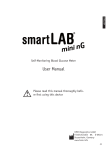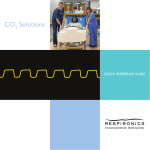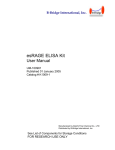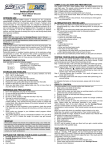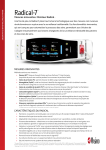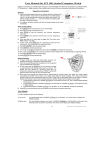Download Glucertain® Blood Glucose Test Strips Product Insert
Transcript
ALTERNATE SITE TESTING (AST) 1. Blood Glucose Test Strips Instructions 2. INTENDED USE Glucertain® Blood Glucose Test Strips are intended for the quantitative measurement of glucose in venous blood or fresh capillary whole blood samples drawn from the fingertips, palm, or forearm. Glucertain Blood Glucose Test Strips must be used with the Glucertain Blood Glucose Meter. Testing is done outside the body (In Vitro diagnostic use). The Glucertain Blood Glucose Monitoring System is indicated for use in clinical settings by healthcare providers, as an aid to monitor the effectiveness of diabetes control. The Glucertain Blood Glucose Monitoring System is not to be used on neonates, nor for the diagnosis of, or screening for diabetes mellitus. Alternate site testing can only be used during steady-state blood glucose conditions. 3. 4. PRINCIPLE1,2 Apply a blood sample to the blood collection area at the tip of the strip. The test strip will draw the blood sample into the reaction zone. The FAD-binding glucose dehydrogenase catalyzes the glucose dehydrogenation. It will produce gluconolactone. During the reaction, a mediator transfers electrons to the electrode surface and generates a current. The amount of the current is proportional to the amount of glucose present in the blood sample. After 5 seconds, the Glucertain meter will show glucose concentration on the screen. REAGENT COMPOSITION Each test strip contains: 6 (w/w) % 56 (w/w) % 38 (w/w) % FAD glucose dehydrogenase (Aspergillus oryzae, 2.0 IU/test strip) Potassium ferricyanide Non-reactive ingredients STORAGE AND HANDLING Glucertain BG Test Strips should be stored at 36-86°F (2-30°C) and 40-85% RH. 2. Keep out of direct sunlight and heat. 3. DO NOT freeze. 4. Write the date on the bottle when initially opened. 5. Discard test strips 6 months after the initial opening date. 6. Replace the cap quickly after taking the test strip from the bottle. 7. Handle the test strip only with dry and clean hands. 8. Store your test strips in their original bottle only. Do not move them to any other bottle or container. 9. Use this system at temperatures between 50°F and 104°F (10°C and 40°C). Outside this range, the system may get inaccurate results. 10. If strips are stored in the refrigerator, the strips should be brought to room temperature before testing. AST results may differ from fingertip results when glucose levels are changing rapidly. (e.g., after a meal, after taking insulin, or during or after exercise). Use AST only during steady-state blood glucose conditions. Perform AST only under the following conditions: ♦ Testing before a meal. ♦ In a fasting state. ♦ 2 hours or more after a meal. ♦ 2 hours or more after insulin dosing. ♦ 2 hours after physical activity. Fingertip test only: ♦ If sick. ♦ If blood glucose is low. ♦ After exercising. ♦ 2 hours or less after eating. ♦ If you often do not notice when blood glucose is low. ♦ When basal insulin is most active. ♦ After injecting rapid-acting insulin (2 hours or less). Consult with the physician before you test palm and forearm. Measurements from alternate site testing should never be used to calibrate a continuous glucose monitor (CGM) or entered into insulin dose calculators for insulin dosing recommendations. PRIOR TO TESTING BLOOD GLUCOSE LEVEL To ensure that the meter is working properly, we recommend performing a test with the meter and control solution prior to testing. Use the Glucertain Glucose Control Solutions to check Glucertain BG system performance. Please follow the “Control Solution Test” section in the User’s Manual. Do not use other manufacturer’s control solutions, as they may provide incorrect results. When the results fall within the specified ranges printed on the strip bottle label, the system is working properly. If control solution readings are outside the range, repeat the control solution test. Results that fall outside the range may be caused by: 1. Expired or contaminated control solution. 2. Error in performing the test. 3. Meter malfunction. 4. Test strip deterioration. 5. Contact Customer Service to verify a meter malfunction 1. WARNINGS AND PRECAUTIONS 1. 2. 3. 4. 5. 6. 7. For in vitro diagnostic use only. Do not swallow. Do not use the test strip after the expiration date. Do not re-use test strips. Do not cut, bend, scratch, or alter the test strip in any way. The Glucertain Blood Glucose Meter should be cleaned and disinfected after every use. Please refer to the User's Manual for information regarding the frequency and instructions of cleaning and disinfection. If the readings are not consistent with the patient’s symptoms, check the user manual for the meter. Make sure you have followed all instructions, and then contact the physician. Make changes to the patient’s diabetes control program only with consultation with the physician. SUPPLIES FOR TESTING YOUR BLOOD GLUCOSE ♦ ♦ ♦ ♦ ♦ Glucertain Meter. Glucertain Test Strips. Glucertain Safety Lancets. Glucertain User’s Manual. Glucertain Glucose Control Solutions. SAMPLE COLLECTION AND PREPARATION This system is for use in venous blood or fresh capillary blood. Use the blood sample immediately. The blood sample volume requires at least 0.6 micro-liters. To obtain a drop of blood, follow these steps: Step 1: Wash & dry your hands thoroughly and glove per facility protocols. Step 2: Obtain a new Glucertain Safety Lancet. Step 3: Clean patient’s fingertip with an alcohol swab. Be sure that the finger is entirely dry before lancing. Step 4: Puncture and get a drop of blood. Once puncture is achieved, remove the lancet from the punctured site. TESTING BLOOD GLUCOSE LEVEL Please follow these steps to test: Step 1: Insert Test Strip. Take a test strip out and recap the bottle quickly. Insert the test strip into the slot of the meter. The meter will turn on automatically. Step 2: Apply Sample. Follow the sample collection procedures to get a drop of blood. While the “” appears, touch the droplet of blood to the collection area. The test strip will draw the blood sample into the reaction zone. The meter will begin to run. Step 3: Accurate Results after 5 seconds. The result will appear on the screen after 5 seconds and be stored in the meter. Step 4: Clean patient's fingertip and absorb any excess blood with absorbent material; wash your hands after performing glucose testing per facility protocol. QUALITY CONTROL It is recommended to run a control solution test whenever you: 1. Begin using a new bottle of test strips. 2. Note that blood glucose results do not match the patient’s symptoms. 3. Feel the meter does not seem to be working properly. 4. Obtain blood glucose results that do not match, suspect the meter or test strips are working incorrectly. 5. Drop the meter. 6. Expose the test strips to temperatures outside the storage conditions. (36°F to 86°F, 2°C to 30°C) Use the Glucertain Glucose Control Solutions to check Glucertain BG system performance. Please follow the “Control Solution Test” section in the User’s Manual. Do not use other manufacturer’s control solutions, as they may provide incorrect results. When the results fall within the specified ranges printed on the strip bottle label, the system is working properly. If control solution readings are outside the range, repeat the control solution test. Results that fall outside the range may be caused by: 1. Expired or contaminated control solution. 2. Error in performing the test. 3. Meter malfunction. 4. Test strip deterioration. IMPORTANT If the control solution test results are outside the range, your meter and test strip may not be working as a system. Follow the correct procedures and repeat the control solution test. Make sure the control solution is not Turbid. Do not use the meter until test results fall within the appropriate range. If the problem continues, call Technical Services toll-free at 866-203-2761 (Eastern Time, Mon-Fri 8:00AM - 5:00PM). READINGS 401~600 mg/dL Test Results are displayed in milligrams per deciliter (mg/dL). If a decimal point appears, please call Technical Services Toll-Free: 866-203-2761. If “LO” appears on the screen, your blood glucose level is lower than 20 mg/dL. If “HI” appears, that your blood glucose level is higher than 600 mg/dL. When you get any questionable readings, check the following items first and then repeat the test. If the results are still questionable: 1. Be sure the strips are within the expiration date. 2. Make sure the drop of blood appears in the whole reaction zone. If the results are still questionable, consult the physician. Expected Results: The Glucertain Blood Glucose test strips are plasma referenced and calibrated for easier comparison to lab results. ♦ For Non-Diabetic Patients3 The American Diabetes Association recommends a post-meal glucose level of less than 140 mg/dL (7.8 mmol/L) and a pre-meal glucose of less than 100 mg/dL (5.6 mmol/L). ♦ For Non-Pregnant Patients4 The American Diabetes Association recommends a post-meal glucose level of less than 180 mg/dL (10.0 mmol/L) and a pre-meal glucose of 70-130 mg/dL (3.9-7.2 mmol/L). All other patients not listed should consult with their physician on their recommended post-meal and pre-meal glucose levels. CAUTION: Any low or high blood glucose readings can indicate a potentially serious medical condition. If the readings do not reflect the patient's symptoms, repeat the test with a new test strip. Contact the physician when the reading is: A. Not consistent with the patient’s symptoms. B. Less than 60 mg/dL. C. Higher than 240 mg/dL. LIMITATIONS When the test strips are used for fresh capillary whole blood samples. 1. DO NOT use neonate blood sample. 2. Extreme humidity may affect the results. A relative humidity greater than 90﹪ may cause incorrect results. 3. DO NOT reuse the test strips. The test strips are for single use only. 4. Hematocrit (HCT): HCT between 20% and 60% will not significantly affect the results. HCT below 20% may cause higher results. HCT above 60% may cause lower results. If patient's HCT is unknown, consult the physician. 5. Altitude up to 10,000 feet above sea level has no effect on readings. 6. Interfering Substances depend on the concentration.The below substances up to the test concentration will not affect the readings. Exogenous Interference data Highest Conc. Bias @ blood Interference tested glucose Conc. 14.2%@80 mg/dL Acetaminophen 8 mg/dL Yes 14.9%@120 mg/dL Ascorbic Acid 4 mg/dL No NA 31.0%@80 mg/dL Dopamine 5.2 mg/dL Yes 18.2%@120 mg/dL Gentisic Acid 6 mg/dL No NA Ibuprofen 50 mg/dL No NA 16.3%@80 mg/dL L-Dopa 4 mg/dL Yes 11.4%@120 mg/dL Methyldopa 2 mg/dL No NA Sodium Salicylate 50 mg/dL No NA Tetracycline 1.5 mg/dL No NA Tolbutamide 100 mg/dL No NA Galactose 20 mg/dL No NA Maltose 20 mg/dL No NA Xylose 8 mg/dL Yes 30 mg/dL 10 mg/dL 50 mg/dL 200 mg/dL 8 mg/dL No No No No No 25 mg/dL No Fructose Manose Sucrose Xylitol Glipizide Bilirubinunconjugated Cholesterol Creatinine Triglycerides 500 mg/dL 30 mg/dL 1000 mg/dL No No No Uric Acid 15.9 mg/dL Yes Control Level 1 Level 2 Level 3 within±5mg/dL 55/180 (30.6%) within±5% 220/438 (50.2%) within±5% 63/134(47.01%) within±5% 66/134(49.25%) within±5mg/dL 8/19 (42.11%) within±5% 59/134(44.03%) 1. 2. 4. 20~50 mg/dL 51~110 mg/dL 111~150 mg/dL 151~250 mg/dL 251~400 mg/dL 200 200 200 200 200 CV(%) 6.5 3.2 3.3 2.9 2.8 Glucose level ≧ 100mg/dL within±10% 357/438 (81.5%) within±15% 422/438 (96.3%) 4.8241 mg/dL 0.9481 Glucose level ≦75mg/dL within±10mg/dL within±15mg/dL 17/19 (89.47%) 19/19 (100%) Glucose level >75mg/dL within±10% within±15% within±20% 99/134(73.88%) 121/134(90.30%) 129/134(96.27%) -11.7596 mg/dL 0.9584 Glucose level ≦75mg/dL within±10mg/dL 16/19 (84.21%) within±15mg/dL 18/19 (94.74%) Glucose level >75mg/dL within±10% within±15% 95/134(70.90%) 113/134(84.33%) within±20% 129/134(96.27%) -4.6425 mg/dL 0.9503 Glucose level ≦75mg/dL within±10mg/dL 14/19 (73.68%) Glucose level >75mg/dL within±10% within±15% 97/134(72.39%) 112/134(83.58%) within±15mg/dL 19/19 (100%) within±20% 128/134(95.52%) REFERENCES 3. GlucertainBG System mean(mg/dL) SD(mg/dL) 40.7 2.6 108.5 3.5 137.0 4.5 223.5 6.4 399.8 11.0 -0.9679 mg/dL 0.9696 within±15mg/dL 175/180 (97.2%) Arm testingSlope 1.0263 Intercept Number of subjects 153 R-square Range tested 50– 514 mg/dL Within-run: For each test range, Use 10 Meters, 2 lots of test strips, 10 pcs test strips at each lot. (N=10 Meters x 2 lots x10 tests X 6 glucose levels =1200), N CV (%) 7.45% 2.56% 2.07% Glucose level < 100mg/dL within±10mg/dL 111/180 ( 61.7%) Hypothenar testingSlope 1.0896 Intercept Number of subjects 153 R-square Range tested 53– 517 mg/dL PRECISION Range(mg/dL) SD(mg/dL) 3.12 3.09 7.24 Thenar testingSlope 0.9688 Intercept Number of subjects 153 R-square Range tested 55– 459 mg/dL NA NA NA 14.3%@80 mg/dL The highest no interference 17.5%@120 mg/dL concentration is 11.9 mg/dL The test range is between 20 to 600 mg/dL. We have validated the performance of test strips in both laboratory and clinical tests. mean(mg/dL) 41.8 120.7 349.8 In comparison to the YSI, Glucertain BG System meets the EN ISO 15197:2013 standard, whereby 95% of the blood glucose values measured must lie within the following ranges: either ±15 mg/dL of the measured average value when using the reference measuring procedure for blood glucose concentrations <100 mg/dL or ±15% for blood glucose concentrations of ≥100 mg/dL. 99% of the individual measured blood glucose values must fall within zones A and B of the Consensus Error Grid (CEG) for diabetes type 1. NA PERFORMANCE CHARACTERISTICS N 400 400 400 Slope 1.0100 Intercept Number of subjects 153 R-square Range tested 58.5– 433.5 mg/dL within±5mg/dL 9/19 (47.37%) The highest no interference 10.1%@80 mg/dL concentration is 6 mg/dL NA NA NA NA NA 2.7 The accuracy of the Glucertain BG System was assessed by comparing to laboratory results. The following results were obtained by 103 subjects with diabetes at three independent clinical sites. The regression statistics are derived from a plot of fingertip capillary data versus YSI (Yellow Springs Instrument Co.) plasma data. Note The highest no interference concentration is 2 mg/dL 13.9 ACCURACY STUDY The highest no interference concentration is 7 mg/dL The highest no interference concentration is 2.6 mg/dL 512.1 This shows that Glucertain BG System has good repeatability. within±5mg/dL 12/19 (63.16%) Exogenous Substances 200 Total-run: Prepare 10 Meters, 2 lots of test strip, level 1, 2, and 3 control solutions. Test each control level twice a day, once in the morning and once in the afternoon for 10 days. (N=10 Meters x 2 Lots x 2 tests x10 days X 3 control solutions=1200), Cass, A.E.G. et al., Anal. Chem., 56 (1984) p.667 Tietz N.: Fundamentals of clinical chemistry, 3rd Ed., W.B. Saunders Co., Philadelphia, PA, 1987, p.427 American Diabetes Association: Diagnosis and Classification of Diabetes Mellitus (Position Statement). Diabetes Care 34 (Supp. 1) S66, 2011. American Diabetes Association. Standards of medical care in diabetes-Table 10. Diabetes care. 2011; Vol. 34, Suppl 1, S21. IMPORTANT Please read these instructions and the manual before using the test strips. If you have any questions, please contact: Technical Services Toll-Free: 866-203-2761 (Eastern Standard Time, Mon-Fri 8:00AM-5:00PM). Glucertain® is a registered trade mark of CellEra, LLC, Cincinnati, Ohio, USA.



